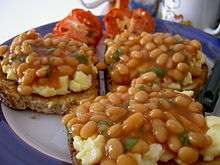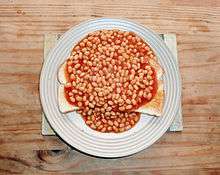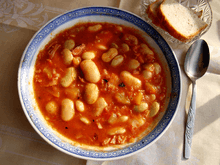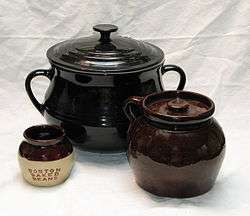Baked beans
Baked beans is a dish traditionally containing white beans which are parboiled and then baked at a low temperature for a lengthy period of time in some sort of sauce. This is the usual preparation of the dish in the United States when not using canned beans.[1] In the United Kingdom the dish is sometimes baked, but usually stewed in a sauce.[2] Canned baked beans are not baked, but are cooked through a steam process.[3]
 Baked beans over scrambled eggs on toast | |
| Associated national cuisine | United States and others |
|---|---|
| Created by | Native Americans; modern versions descended from the colonial United States |
| Serving temperature | Hot or cold |
| Main ingredients | Beans |
| Ingredients generally used | Bacon, ham, or salt pork (US); maple syrup, molasses, or brown sugar (US); mustard (US); onions (US); Tomato sauce (UK & AUS/NZ; sometimes US) |
Baked beans has its origins in Native American cuisine, and the dish is made from beans indigenous to the Americas.[4] The dish was adopted and adapted by English colonists in New England in the 17th century and, through the aid of published 19th century cookbooks, the dish spread to other regions of the United States and into Canada.[4] Today in the New England region of the United States a variety of indigenous legumes are still used when preparing this dish in restaurants or in the home, such as Jacob's cattle, soldier beans, yellow-eyed beans, and navy beans (also known as native beans).[4]
Originally baked beans were sweetened with maple syrup by Native Americans, a tradition some recipes still follow, but some English colonists modified the sweetening agent to brown sugar beginning in the 17th century. In the 18th century the convention of using American-made molasses as a sweetening agent became increasingly popular in order to avoid British taxes on sugar. American Boston baked beans use a sauce prepared with molasses and salt pork, the popularity of which has led to the city's being nicknamed "Beantown".[5] Today baked beans is commonly served throughout the United States alongside barbecue food of various kinds and at picnics. Beans in a brown sugar, sugar, or corn syrup sauce (sometimes with and sometimes without a tomato base) are widely available throughout the United States. Bush Brothers and Company currently sells the most baked beans in the United States.[6]
Canned baked beans are used as a convenience food, and most commercially canned baked beans are made from haricot beans, also known as navy beans (a variety of Phaseolus vulgaris) in a sauce. They may be eaten hot or cold, straight from the can, as they are already fully cooked.[7] Mass production of canned baked beans began in the United States in 1895 by the H. J. Heinz Company. In the early 20th century, canned baked beans became popular internationally, particularly in the United Kingdom where the greatest amount of canned baked beans is currently consumed as part of a standard English full breakfast.
Origins and history in the Americas
According to chef and food historian Walter Staib of Philadelphia's City Tavern, baked beans had its roots as a Native peoples dish in the Americas long before the dish became known to Western culture.[8] Native Americans mixed beans, maple sugar, and bear fat in earthenware pots which they placed in underground "bean holes" which were lined in hot rocks to cook slowly over a long period of time.[8]
British colonists in New England were the first westerners to adopt the dish from the Native peoples; and were quick to embrace it largely because the dish was reminiscent of peas porridge and because the dish used ingredients native to the New World.[8][9] They substituted molasses or sugar for the maple syrup, bacon or ham for the bear fat, and simmered their beans for hours in pots over the fire instead of underground.[8] Each colony in America had its own regional variations of the dish, with navy or white pea beans used in Massachusetts, Jacob's Cattle and soldier beans used in Maine, and yellow-eyed beans in Vermont.[4] This variation likely resulted from the colonists receiving the dish from different Native peoples who used different native beans.[4]
While some historians have theorized that baked beans had originated from the cassoulet or bean stew tradition in Southern France, this is unlikely as the beans used to make baked beans are all native to South America and were introduced to Europe around 1528.[10] However, it is likely that English colonists used their knowledge of cassoulet cooking to modify the cooking technique of the beans from the traditional Native American version, by soaking the bean overnight and simmering the beans over a fire before baking it in earthen pots in order to decrease the cooking time.[11] Indeed, a dish which was a clear precursor to baked beans, entitled "beans and bacon", was known in medieval England.[12] The addition of onion and mustard to some baked beans recipes published in New England in the 19th century was likely based on traditional cassoulet recipes from Staffordshire, England which utilized mustard, beans, and leeks.[11] These ingredients are still often added to baked beans today.[11] Nineteenth century cookbooks published in New England, spread to other portions United States and Canada, which familiarized other people with the dish.[11]
While many recipes today are stewed, traditionally dried beans were soaked over night, simmered until tender (parboiled), and then slow-baked in a ceramic or cast-iron beanpot.[4] Originally baked beans were sweetened with maple syrup by Native Americans, a tradition some recipes still follow, but some English colonists modified the sweetening agent to brown sugar beginning in the 17th century.[12] In the 18th century the convention of using American made molasses as a sweetening agent became increasingly popular in order to avoid British taxes on sugar.[12] The molasses style of baked beans has become closely associated with the city of Boston, and is often referred to as Boston baked beans. Today in the New England region, baked beans are flavored either with maple syrup (Northern New England), or with molasses (Boston), and are traditionally cooked with salt pork in a beanpot in a brick oven for six to eight hours.[13] In the absence of a brick oven, the beans were cooked in a beanpot nestled in a bed of embers placed near the outer edges of a hearth, about a foot away from the fire. Today, baked beans can be made in a slow cooker or in a modern oven using a traditional beanpot, Dutch oven, or casserole dish.[11] The results of the dish, commonly described as having a savory-sweet flavor and a brownish- or reddish-tinted white bean, however cooked are the same.[8]
A tradition in Maine of "bean hole" cooking may have originated with the native Penobscot people and was later practiced in logging camps. A fire would be made in a stone-lined pit and allowed to burn down to hot coals, and then a pot with 11[14] pounds of seasoned beans would be placed in the ashes, covered over with dirt, and left to cook overnight or longer. These beans were a staple of Maine's logging camps, served at every meal.[15][16]
While baked beans was initially a New England region cuisine, the dish has become a popular item throughout the United States; and is now a staple item served most frequently along various types of barbecue and at picnics.[17] This is due in part to the ease of handling, as they can be served hot or cold, directly from the can, making them handy for outdoor eating. The tomato-based sweet sauce also complements many types of barbecue. The already-cooked beans may also be baked in a casserole dish topped with slices of raw bacon, which is baked until the bacon is cooked. Additional seasonings are sometimes used, such as additional brown sugar or mustard to make the sauce more tangy.[7]
History of commercial production and international consumption

Canned beans, often containing pork, were among the first convenience foods, and it is in this form that they became exported and popularised by U.S. companies internationally in the early 20th century.[18] The U.S. Food and Drug Administration stated in 1996, "It has for years been recognized by consumers generally that the designation 'beans with pork,' or 'pork and beans' is the common or usual name for an article of commerce that contains very little pork."[19] The included pork is typically a piece of salt pork that adds fat to the dish. Canned baked beans with small pork sausages is also available.[20]
The first mass-produced commercial canning of baked beans in the United States began in 1895 by the Pennsylvania-based H. J. Heinz Company.[6] They were also the first company to sell baked beans outside of the United States, beginning with sales limited solely to Fortnum & Mason in 1886 when the item was considered a luxury.[21] They later expanded to selling throughout the United Kingdom in 1901, and baked beans became a standard part of the English full breakfast soon after.[6] Originally, Heinz baked beans were prepared in the traditional United States manner for sales in Ireland and Great Britain. Over time, the recipe was altered to a less sweet tomato sauce without maple syrup, molasses, or brown sugar in order to appeal to the tastes of the United Kingdom.[18] It is this version of baked beans which is most commonly used outside of the United States. Baked beans are commonly eaten on toast or as part of a full English, Scottish, or Irish breakfast.[18]
Today, baked beans are a staple convenience food in the UK, often eaten as part of the modern full English breakfast and particularly on toast (called simply "beans on toast").[18] Heinz Baked Beans remains the best-selling brand in the UK.[22] In America, the H. J. Heinz Co. continue to sell baked beans, although they are not always as widely distributed as competing American brands. Despite their international fame, there are currently substantial differences between the Heinz baked beans produced for the UK market (descended from the original American recipe) and the nearest currently equivalent American product (Heinz Premium Vegetarian Beans).
The American product contains brown sugar where the British beans do not, and the U.S. product contains 14 g of sugar per 16 oz tin[23] compared to 7 g for the British version (equating to 140 versus 90 calories). The U.S. beans have a mushier texture and are darker in color than their UK counterpart. This has resulted in a situation where the product is now imported back to the brand's home country. For several years, UK Heinz Baked Beans have been available in the U.S., either in different-sized cans from those sold in the UK or in a 385-gram can (the same can as the 415-gram can in the UK) with an "export" label with American English spelling and the word "baked" dropped from the title on the label. These are sold in many U.S. specialty stores, attesting to the popularity of baked beans and their appeal to expatriates. Bush, Van Camp, B&M, and Heinz all produce pork-free baked beans labeled as vegetarian beans, making this American dish available to people who abstain from pork for religious, dietary, or ethical reasons.
The Baked Bean Museum of Excellence is a museum located in Port Talbot, Wales, United Kingdom which is dedicated to baked beans.[24]
Around the world

Traditional cuisines of many regions claim such recipes as typical specialities, for example:
- In Poland, with the addition of bacon and/or sausage, these are known as Breton beans (fasolka po bretońsku).[25]
- In France these are known as cocos de Paimpol à la bretonne.
- Jersey bean crock
- Boston baked beans
- Pork and beans, which despite the name often contain very little pork
- Guernsey Bean Jar
- Spanish Cocido Montañés
- Cassoulet (South-western France)
- Feijoada
- Fasolada
- Frijoles charros, pinto beans cooked with bacon and sometimes tomatoes, are popular in Mexico and the American border states.
- Greek Fasolia Gigandes Gigandes plaki
- In the Italian cuisine beans (of various size and various types) are widely used for several recipes also mixed with other ingredients: "fagiolata" generally stands for baked beans but there are also regional variations like "fagioli all'uccelletto" in Florence; "minestra di fagioli" (beans soup normally cooked with vegetables) "pasta e fagioli" (meaning "pasta and beans").
- New England baked beans
- Quebec-style baked beans are often prepared with maple syrup.
- Bean-hole beans, traditionally from Northern New England and Quebec, cooked in a covered fire pit in the ground for up to two days
- British cuisine claims beans on toast as a teatime favourite, the combination of cereal and legume forming an inexpensive complete protein; compare rice and beans. Variations of "beans on toast deluxe" can include extras as such as egg, grated cheese, marmite, tuna etc., and baked beans sometimes form part of a full English breakfast.
- Beans cooked in barbecue sauce (or a similarly flavoured sauce) are a traditional side dish in an American barbecue.
- "Franks & beans", a recipe wherein hot dogs are cut up and cooked in the same sauce as the baked beans. In Canada, this recipe is more commonly called "beans and wieners".
- In the north of the Netherlands brown beans are often stewed and served with lardons baked until crisp, pickled silverskin onions and gherkins, and sugar syrup or apple syrup. In the province of Drenthe, this dish has a cultural significance due to the regional nostalgic novel and TV series Bartje.
- In Mexico and Latin America baked beans are also popular: black beans (frijoles negros) and frijoles pintos (pinto beans) are the most common.
- Chilean porotos con riendas
- In the Balkans, they are known as prebranac.
- The traditional Jewish Shabbat dish cholent (also known as hamin) is made with meat, potatoes, beans and barley.
- Turkish Fasolia (fasulye), usually served with rice
- Iranian Loobia Chiti is made from pinto beans, usually served with olive oil and lemon juice.
Many unusual dishes are made with baked beans including the baked bean sandwich. These are slices of bread topped with beans and other additions, such as melted cheese.
Health
In 2002, the British Dietetic Association allowed manufacturers of canned baked beans to advertise the product as contributing to the recommended daily consumption of five to six vegetables per person. This concession was criticised by heart specialists, who pointed to the high levels of sugar and salt in the product. However, it has been proven that consumption of baked beans does indeed lower total cholesterol levels and low-density lipoprotein cholesterol, even in normo-cholesterolaemic individuals.[26][27] Some manufacturers produce a "healthy" version of the product with reduced levels of sugar and salt.[28]
Flatulence
Baked beans are known on occasion to cause a considerable increase in flatulence following consumption;[29][30] this is due to the fermentation of polysaccharides (specifically oligosaccharides) by gut flora, specifically Methanobrevibacter smithii. The oligosaccharides pass through the small intestine largely undigested; when they reach the large intestine, they are digested by the bacteria, producing large amounts of gas.[31]
This condition is referenced in multiple works of popular culture. Some prominent examples include:
- The campfire scene in Mel Brooks's film Blazing Saddles,[32] in which the cowboys' banter is punctuated by fusillades of flatulence
- The children's song "Beans, Beans, the Musical Fruit"/"Beans, Beans, Good for the Heart", which carries the refrain "The more you eat, the more you [toot/fart]".
- Terry Gilliam’s bean-obsessed (and bean-covered) character in the Monty Python sketch The Most Awful Family in Britain.
See also
| Wikimedia Commons has media related to Baked beans. |
- Cassoulet
- List of legume dishes
- List of toast dishes
- Pork and beans
- Refried beans
- Tavče gravče, a traditional Macedonian dish
References
- Ken Alba (2007). Beans: A History. London: Oxford International Publishers.
- Thring, Oliver (22 February 2011). "Consider baked beans". The Guardian. London.
- Lauren O'Callaghan (9 August 2016). "How are your baked beans REALLY made? Behind the scenes footage at a factory reveals ALL". BBC Express.
- Michael Sletcher, ed. (2004). The Greenwood Encyclopedia of American Regional Cultures: New England. London: Greenwood Press. pp. 233–235.
- Dalager, Norman (10 August 2006). "What's in a nickname?". The Boston Globe. Archived from the original on 23 July 2013. Retrieved 5 July 2013.
- Teresa F. Lindeman (25 January 2012). "Heinz brings beans back to U.S." Pittsburgh Post-Gazette.
- "GuardianWitness - Cold Baked Beans salad". GuardianWitness. Archived from the original on 2 October 2017. Retrieved 2 October 2017.
- Walter Staib (1999). City Tavern Cookbook: 200 years of Classic Recipes from America's First Gourmet Restaurant. London: Running Press. p. 115.
- Michael Sletcher, ed. (2004). The Greenwood Encyclopedia of American Regional Cultures: New England. London: Greenwood Press. p. xviii.
- "Food History: A timeline". Kid Cyber. Retrieved 16 August 2016.
- Keith Stavely, Kathleen Fitzgerald (2004). America's Founding Food: The Story of New England Cooking. University of North Carolina Press. pp. 51–58.
- Mark McWilliams (2012). "The Story behind the Dish: Classic American Foods: Classic American Foods". Denver, Colorado: Greenwood Press. p. 11.
- Farmer, Fannie (1896). Boston Cooking-School Cook Book'. p. 212. ISBN 0-451-12892-3.
- "Common Ground's Bean Hole Beans". Mofga.org. Archived from the original on 7 March 2013. Retrieved 2 November 2012.
- "Foodways Research: A Taste of Maine". Maine Folklife Center. Archived from the original on 18 August 2009.
- "Archived copy". Archived from the original on 18 August 2009. Retrieved 19 August 2009.CS1 maint: archived copy as title (link), Maine Folklife Center
- Robert F. Moss (2010). Barbecue: The History of an American Institution. University of Alabama Press. p. 25.
- Felicity Cloake (1 May 2014). "How to cook the perfect baked beans". The Guardian.
- "That's What and Beans? Pork Defends Its Image". The New York Times. 1 April 1998.
- "Heinz Beanz with pork sausages". heinz.co.uk. 11 October 2017.
- "Fortnum's History". Fortnum & Mason. Retrieved 11 September 2019.
- "Heinz to change baked beans recipe as it faces Branston challenge". campaignlive.co.uk.
- Vegetarian Beans – Premium. "Heinz Vegetarian Beans – Premium 16.00 oz Netgrocer". Netgrocer.com. Archived from the original on 2 October 2011. Retrieved 2 November 2012.
- Davies, Hunter (2010). "Chapter 4: The Baked Bean Museum of Excellence, Port Talbot". Behind the scenes at the Museum of Baked Beans: My search for Britain's Maddest Museums. Virgin Books. pp. 59–72. ISBN 978-0-7535-2213-4.
- "We can see certain influences from the west (from France we took baked beans a la bretonne, surprisingly not known in today's Brittany) [in:] Culinary cultures of Europe: identity, diversity and dialogue by Darra Goldstein, Kathrin Merkle, Stephen Mennell. 2005
- Susan M. Shutler, Gemma M. Bircher, Jacki A. Tredger, Linda M. Morgan, Ann F. Walker and A. G. LOW (1989). The effect of daily baked bean (Phaseolus vulgaris) consumption on the plasma lipid levels of young, normo-cholesterolaemic men. British Journal of Nutrition, 61, pp 257–265 doi:10.1079/BJN19890114.
- Donna M. Winham, Andrea M. Hutchins. Baked bean consumption reduces serum cholesterol in hypercholesterolemic adults. Nutrition research (New York, N.Y.) 1 July 2007 (volume 27 issue 7 Pages 380–386 doi:10.1016/j.nutres.2007.04.017).
- "Our top 5 baked beans - Healthy Kids". healthy-kids.com.au. Retrieved 29 September 2018.
- "Health | Experts make flatulence-free bean". BBC News. 25 April 2006. Archived from the original on 31 March 2009. Retrieved 25 February 2009.
- "Flatulence – Overview – Introduction". Nhs.uk. Archived from the original on 21 February 2009. Retrieved 25 February 2009.
- McGee, Harold (1984). On Food and Cooking. Scribner. pp. 257–8. ISBN 0-684-84328-5.
- "Blazing Saddles --Farting Cowboys- Greatest Fart Scene of All Time". youtube.com. Retrieved 29 September 2018.
